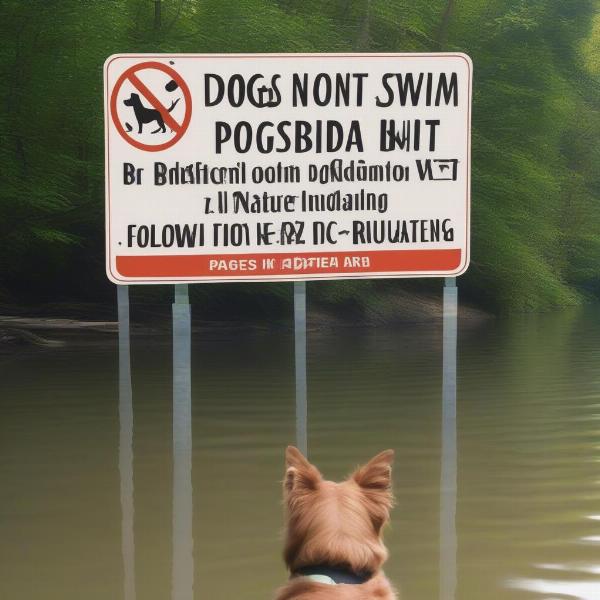Dog caution signs play a vital role in ensuring the safety and well-being of our furry companions. These signs communicate potential hazards, restrictions, or responsibilities to dog owners, helping to prevent accidents and promote a harmonious environment for both dogs and people. Whether you’re a seasoned dog owner or just starting your journey with a canine companion, understanding these signs is crucial for responsible dog ownership.
Decoding Common Dog Caution Signs
Dog caution signs come in various forms, from simple text-based notices to internationally recognized symbols. Recognizing and adhering to these signs is a key aspect of responsible dog ownership.
“Beware of Dog” Signs: Understanding the Implications
Perhaps the most recognizable dog caution sign is the “Beware of Dog” sign. This sign alerts visitors to the presence of a dog on the property and serves as a warning of potential danger. While these signs can deter unwanted intrusions, they also carry a significant responsibility for dog owners. Owners must ensure their dogs are properly contained and trained to prevent aggressive behavior. A “Beware of Dog” sign does not absolve owners of liability in case of an incident.
“No Dogs Allowed” Signs: Respecting Restrictions
“No Dogs Allowed” signs clearly indicate that dogs are not permitted in a specific area. These signs are often found in public spaces like restaurants, shops, or parks, and serve to maintain hygiene, protect wildlife, or ensure the safety of other visitors. Respecting these restrictions is crucial for maintaining a positive image of dog owners and ensuring continued access to public spaces for well-behaved canines.
Leash Required Signs: Promoting Responsible Dog Walking
Leash laws and designated leash areas are common in many communities. “Leash Required” signs remind dog owners of their responsibility to keep their dogs on a leash in designated areas. This practice not only protects the dog from traffic or getting lost but also prevents unwanted interactions with other dogs or people. Using a leash provides control and helps prevent potential conflicts.
Dog Waste Signs: Maintaining Cleanliness and Hygiene
“Clean Up After Your Dog” signs emphasize the importance of responsible pet waste disposal. Dog waste carries bacteria and parasites that can contaminate public spaces and pose health risks to humans and other animals. Carrying waste bags and disposing of them properly is a simple yet crucial step in maintaining a clean and healthy environment for everyone.
Specific Dog Caution Signs and Their Meanings
Beyond the common signs, several specialized signs address specific situations or hazards. Understanding these signs is equally important for ensuring your dog’s safety and well-being.
Signs Indicating Prohibited Activities: Protecting Wildlife and Ecosystems
In natural areas like parks and reserves, you might encounter signs prohibiting specific activities with dogs, such as swimming in designated areas or disturbing wildlife. These signs aim to protect fragile ecosystems and ensure the safety of both dogs and local wildlife.
 Dog Prohibited from Swimming Sign
Dog Prohibited from Swimming Sign
Signs Related to Specific Breeds: Addressing Breed-Specific Regulations
Some areas may have breed-specific regulations, and signs may indicate restrictions or requirements for certain breeds. These regulations are often controversial and vary by location, so it’s essential to be aware of the local laws concerning your dog’s breed.
Conclusion: Prioritizing Dog Safety Through Awareness
Understanding and respecting dog caution signs is fundamental to responsible dog ownership. By paying attention to these signs, we can create a safer and more enjoyable environment for our dogs and the community. Remember, being a responsible dog owner involves not only caring for your dog’s individual needs but also considering the impact your dog has on others and the environment.
FAQ
- What should I do if my dog doesn’t respond well to leash laws? Consider professional dog training to address leash reactivity and improve your dog’s behavior on walks.
- Are there fines for not cleaning up after my dog? Yes, many communities impose fines for failing to clean up dog waste. Check your local ordinances for specific penalties.
- What does a yellow ribbon on a dog’s leash mean? A yellow ribbon typically signifies that a dog needs space and should not be approached directly.
- Can I ignore “No Dogs Allowed” signs if my dog is well-behaved? No, these signs should be respected regardless of your dog’s behavior. Exceptions may exist for service dogs.
- Where can I find information about local leash laws and regulations? Contact your local animal control or city hall for information on specific regulations in your area.
- What if I see a dog off-leash in a leash-required area? You can politely remind the owner of the leash law or contact animal control if the situation poses a safety concern.
- Are there resources available for learning more about dog body language and caution signs? Yes, many online resources and books offer valuable insights into canine communication and behavior.
ILM Dog is your trusted partner in navigating the world of dog care. We offer comprehensive resources and expert advice on all aspects of dog ownership, from breed selection and health care to training and nutrition. Whether you’re a first-time dog owner or a seasoned pro, ILM Dog is here to help you provide the best possible care for your canine companion. Contact us today at [email protected] or +44 20-3965-8624 for personalized guidance and support.